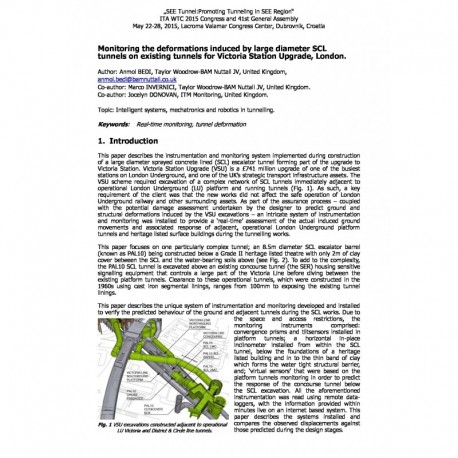Cart
0
0
No document
0,00 €
Total
Document successfully added to your shopping cart
Quantity
Total
There are 0 items in your cart.
There is 1 item in your cart.
Total documents
Total shipping
To be determined
Total
Search & filter
Search for a publication
Search & filter
Monitoring the deformations induced by large diameter SCL tunnels on existing tunnels for Victoria Station Upgrade, London
wtc2015_full_bedi
A. Bedi / M. Invernici / J. Donovan
This paper describes the instrumentation and monitoring system implemented during construction of a large diameter sprayed concrete lined (SCL) escalator tunnel forming part of the upgrade to Victoria Station. Victoria Station Upgrade (VSU) is a £741 million upgrade of one of the busiest stations on London Underground, and one of the UK’s strategic transport infrastructure assets. The VSU scheme required excavation of a complex network of SCL tunnels immediately adjacent to operational London Underground (LU) platform and running tunnels . As such, a key requirement of the client was that the new works did not affect the safe operation of London Underground railway and other surrounding assets. As part of the assurance process – coupled with the potential damage assessment undertaken by the designer to predict ground and structural deformations induced by the VSU excavations – an intricate system of instrumentation and monitoring was installed to provide a ‘real-time’ assessment of the actual induced ground movements and associated response of adjacent, operational London Underground platform tunnels and heritage listed surface buildings during the tunnelling works. This paper focuses on one particularly complex tunnel; an 8.5m diameter SCL escalator barrel (known as PAL10) being constructed below a Grade II heritage listed theatre with only 2m of clay cover between the SCL and the water-bearing soils above (see. To add to the complexity, the PAL10 SCL tunnel is excavated above an existing concourse tunnel (the SER) housing sensitive signalling equipment that controls a large part of the Victoria Line before diving between the existing platform tunnels. Clearance to these operational tunnels, which were constructed in the 1960s using cast iron segmental linings, ranges from 100mm to exposing the existing tunnel linings. This paper describes the unique system of instrumentation and monitoring developed and installed to verify the predicted behaviour of the ground and adjacent tunnels during the SCL works. Due to the space and access restrictions, the monitoring instruments comprised: convergence prisms and tiltsensors installed in platform tunnels; a horizontal in-place inclinometer installed from within the SCL tunnel, below the foundations of a heritage listed building and in to the thin band of clay which forms the water tight structural barrier, and; ‘virtual sensors’ that were based on the platform tunnels monitoring in order to predict the response of the concourse tunnel below the SCL excavation. All the aforementioned instrumentation was read using remote data-loggers, with the information provided within minutes live on an internet based system. This paper describes the systems installed and compares the observed displacements against those predicted during the design stages.




